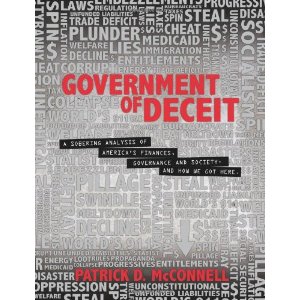
Patrick McConnell: Government of Deceit–A sobering analysis…
• The “entitlement programs” have an unfunded liability of greater than $104 trillion. Your share is $367,000. (Every man, woman and child owes the same.)
• At the end of 2009, $3.2 trillion of the $12.9 trillion National Debt was spent, but never on the government's general budget. Where did 3.2 Trillion dollars go?
• In 2010, the federal government is borrowing 52 cents of every dollar that it spends on general operations. Just to balance the budget, spending will have to be cut by 52%.
• Over the next four years, the federal government needs to borrow at least $3.9 trillion and the world is basically running out of money for us.
Robert Reich: The Economic Truth That Nobody Will Admit: We're Heading Back Toward a Double-Dip
Washington, meanwhile, doesn't want to sound the economic alarm. The White House and most Democrats want Americans to believe the economy is on an upswing.
Republicans, for their part, worry that if they tell it like it is Americans will want government to do more rather than less. They'd rather not talk about jobs and wages, and put the focus instead on deficit reduction (or spread the lie that by reducing the deficit we'll get more jobs and higher wages).
Joseph E. Stiglitz: Why I didn't sign deficit letter
I believe the Bowles Simpson recommendations represent, to too large an extent, a set of unprincipled political compromises that would lead to a weaker America — with slower growth and a more divided society.
Jim Quinn: “Extend and Pretend”: The Severe Ramifications of Wall Street's Game
We now have an economy in which five banks control over 50 percent of the entire banking industry, four or five corporations own most of the mainstream media, and the top one percent of families hold a greater share of the nation’s wealth than any time since 1930. This sort of concentration of wealth and power is a classic setup for the failure of a democratic republic and the stifling of organic economic growth.
Nomi Prins: Top Ten Ways Things Could Get Worse from Here
 |
The government has nearly convinced the public they have everything under control, when that’s far from the case. In fact, everything could go downhill fast. Here are ten all-too-likely scenarios I look at in my book, It Takes a Pillage:
1. The actual bailout has quietly ballooned to $16 trillion dollars (not including over $3 trillion set aside for money market funds), most of it given out with no strings attached. Wall Street firms could continue to tout the myth that ‘talent’ must be paid for – now with stupid sums of bonus money, funded by the American People.
2. The stock market, which has rallied substantially since the government started giving out free money to the banking industry, could tank on the realization that if that money needed to be paid back any time soon, the banks wouldn’t be good for it.
3. Because bigger is better still seems to be Fed policy, JPM Chase could acquire Bank of America – Merrill Lynch, creating one of the largest, federally subsidized banking firms in the world.
4. Because the bigger just can’t help getting badder, JPM Chase could also acquire Citigroup, and we’d be living with a monopoly economy.
5. We could sink into the delusion that the Obama administration has actually done something to restrain Wall Street, lulling us into a false sense of security. Then the remaining big banks will screw us again.
6. Congress could continue to ignore history and never reinstate the Glass-Steagall Act. That act made banks smaller, more specialized, easier to regulate and less expensive to bail out. Repealing it lead to this mess, and there’s barely a whisper heard in Washington of bringing it back.
7. As a Fed approved bank holding company, Goldman Sachs could buy a lot of small banks just to get access to all the money in savings and checking accounts to gamble with. Plus they’d have that great $250,000 FDIC guarantee they get per account. This would make them the biggest bank in the country.
8. Every bank and government agency with access to some aspect of a federal bailout could max out their subsidies chips at once – pushing the full bailout cost to over $26 trillion.
9. Many mid-sized and smaller banks didn’t need a bailout and have been better at allowing consumers access to credit. The largest banks, flush with federal funding and a poor record of helping average Americans, could buy them all up.
10. The Fed could continue to operate in secrecy, despite multiple moves by Congress to push for a full audit of its largesse. Right now, only the Fed knows what the real worst case scenarios might actually be.



